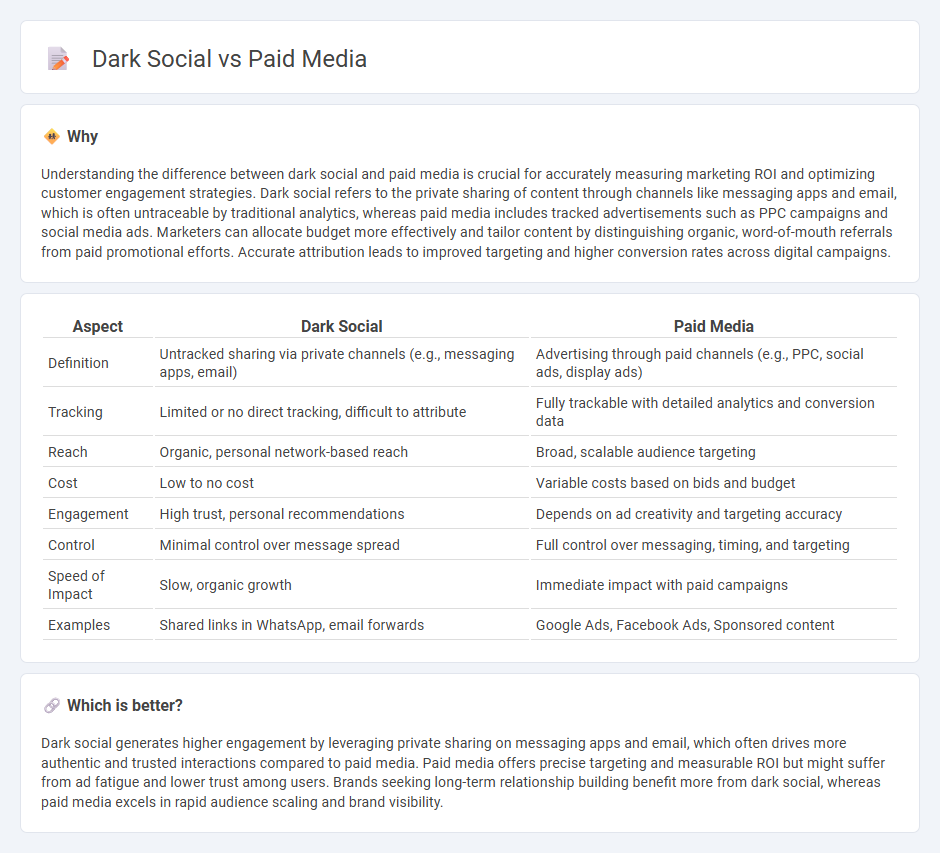
Dark social refers to the untraceable sharing of content through private channels like messaging apps and email, making it challenging for marketers to measure its impact accurately. Paid media involves investing in advertisements across platforms such as Google Ads, Facebook, and Instagram to drive targeted traffic and measurable results. Explore the differences and benefits of dark social and paid media to optimize your marketing strategy.
Why it is important
Understanding the difference between dark social and paid media is crucial for accurately measuring marketing ROI and optimizing customer engagement strategies. Dark social refers to the private sharing of content through channels like messaging apps and email, which is often untraceable by traditional analytics, whereas paid media includes tracked advertisements such as PPC campaigns and social media ads. Marketers can allocate budget more effectively and tailor content by distinguishing organic, word-of-mouth referrals from paid promotional efforts. Accurate attribution leads to improved targeting and higher conversion rates across digital campaigns.
Comparison Table
| Aspect | Dark Social | Paid Media |
|---|---|---|
| Definition | Untracked sharing via private channels (e.g., messaging apps, email) | Advertising through paid channels (e.g., PPC, social ads, display ads) |
| Tracking | Limited or no direct tracking, difficult to attribute | Fully trackable with detailed analytics and conversion data |
| Reach | Organic, personal network-based reach | Broad, scalable audience targeting |
| Cost | Low to no cost | Variable costs based on bids and budget |
| Engagement | High trust, personal recommendations | Depends on ad creativity and targeting accuracy |
| Control | Minimal control over message spread | Full control over messaging, timing, and targeting |
| Speed of Impact | Slow, organic growth | Immediate impact with paid campaigns |
| Examples | Shared links in WhatsApp, email forwards | Google Ads, Facebook Ads, Sponsored content |
Which is better?
Dark social generates higher engagement by leveraging private sharing on messaging apps and email, which often drives more authentic and trusted interactions compared to paid media. Paid media offers precise targeting and measurable ROI but might suffer from ad fatigue and lower trust among users. Brands seeking long-term relationship building benefit more from dark social, whereas paid media excels in rapid audience scaling and brand visibility.
Connection
Dark social channels, such as private messaging apps and email shares, significantly impact paid media strategies by driving untracked traffic that can obscure the full effectiveness of advertising campaigns. Paid media efforts leverage analytics and attribution models to better capture and understand the influence of dark social interactions on consumer behavior and conversion rates. Integrating dark social insights with paid media data enables marketers to optimize budget allocation and enhance targeting precision across digital marketing ecosystems.
Key Terms
Attribution
Paid media attribution relies on tracking tools like UTM parameters and pixel tracking to measure the effectiveness of ads across channels such as Google Ads, Facebook, and programmatic platforms. Dark social attribution is challenging because traffic comes from private channels like messaging apps, email, or shared links without visible referral data, complicating analytics and ROI assessment. Explore advanced attribution models and tools designed to capture dark social impact and optimize marketing strategies effectively.
Reach
Paid media drives reach by leveraging targeted ads on platforms like Facebook, Google, and Instagram, enabling brands to access large, measurable audiences quickly. Dark social refers to private sharing channels such as messaging apps or email, where content spreads organically without direct tracking, often accounting for a significant, underestimated portion of overall reach. Explore how integrating strategies for paid media and dark social can amplify your brand's visibility and impact.
Trackability
Paid media offers precise trackability through analytics platforms, enabling marketers to measure impressions, clicks, conversions, and ROI accurately. Dark social, comprising private sharing via messaging apps and email, lacks transparent tracking capabilities, making attribution and performance analysis challenging. Explore effective strategies to enhance tracking in both paid media and dark social channels.
Source and External Links
What is Paid Media? - ActiveCampaign - Paid media is marketing that you pay for, including TV ads, print ads, pay-per-click (PPC) ads, paid social media ads, and search engine marketing, allowing you to instantly reach and engage your target audience.
What Is Paid Media? - Coursera - Paid media is any content a business invests in to reach its target audience, such as sponsored social posts, video ads, PPC ads, and uses pay models like cost per click (CPC) or cost per mille (CPM) to maximize brand awareness or direct traffic.
What is paid media? Definition, strategies, and campaigns - Adobe Blog - Paid media refers to marketing where advertisers pay to place content in front of a targeted audience, offering precise control over targeting, timing, and budget, making it a vital part of a complete marketing strategy distinct from owned and earned media.
 dowidth.com
dowidth.com